Archives
-
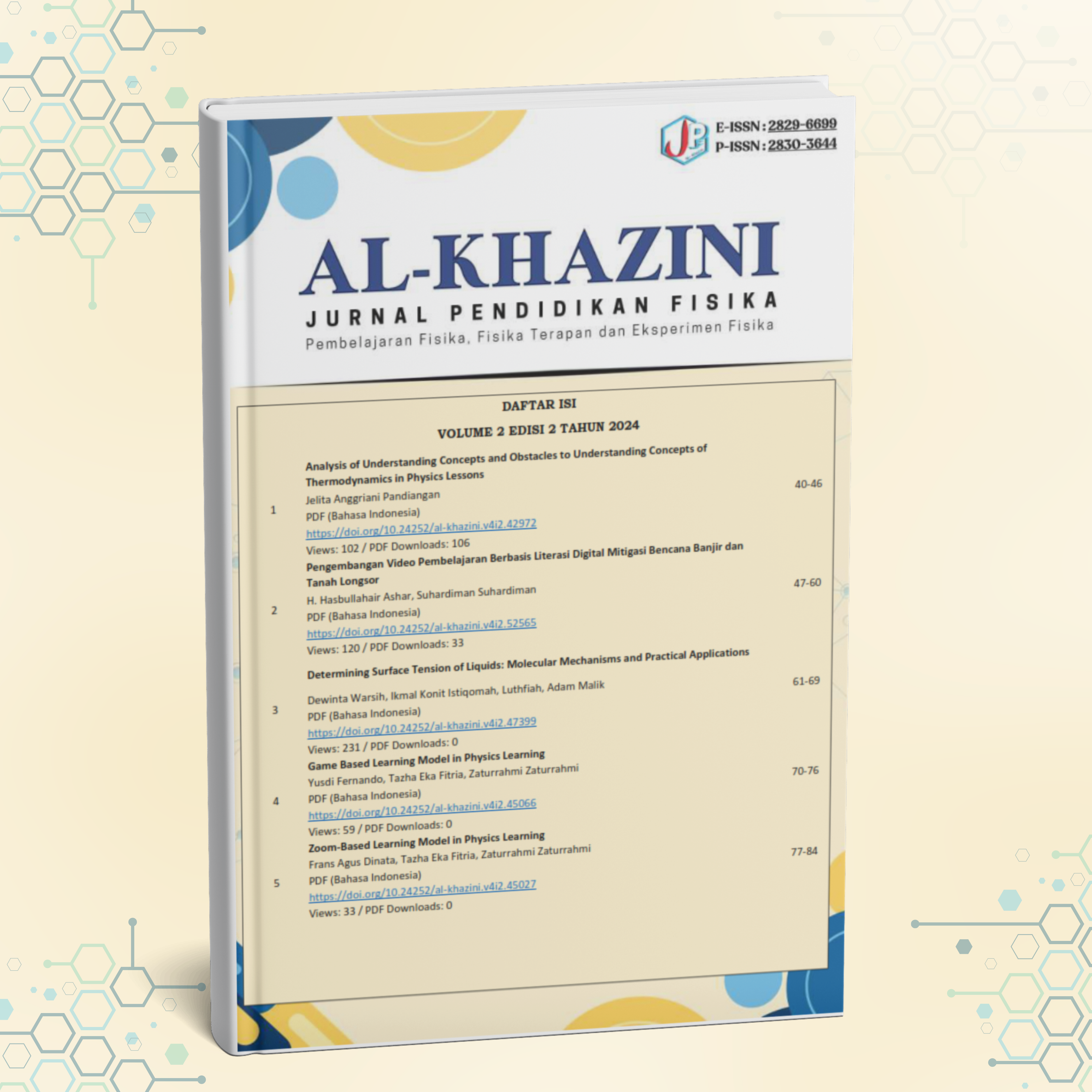 OKTOBER
Vol. 4 No. 2 (2024)
OKTOBER
Vol. 4 No. 2 (2024)Volume 4, Issue 2 of Al-Khazini: Jurnal Pendidikan Fisika (2024) presents a collection of insightful articles exploring significant topics in the field of physics education. This issue highlights various teaching methods, including the integration of digital learning tools, game-based learning, and Zoom-based learning models to enhance the teaching and learning of physics concepts. Articles cover a range of subjects, from understanding the principles of thermodynamics to the development of digital literacy-based video learning for disaster mitigation. It also addresses practical applications in physics, such as surface tension and the Carnot cycle. This volume aims to provide valuable perspectives and innovative approaches for educators and researchers in the field of physics education.
-
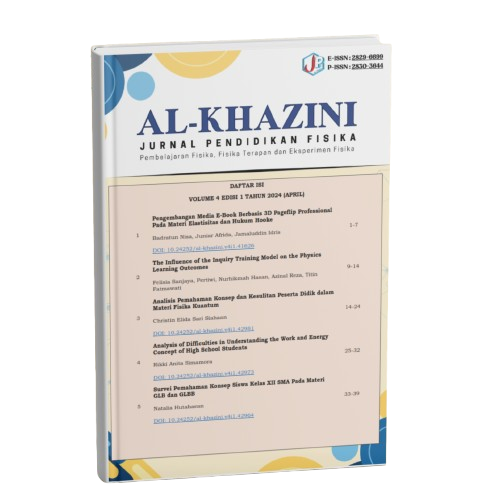 APRIL
Vol. 4 No. 1 (2024)
APRIL
Vol. 4 No. 1 (2024)Volume 4, Issue 1 of Al-Khazini: Jurnal Pendidikan Fisika (2024) features a collection of articles that delve into key topics in physics education. This issue explores innovative approaches to teaching physics, including the development of 3D Pageflip e-books for teaching elasticity and Hooke’s law, the influence of the inquiry training model on physics learning outcomes, and the analysis of student difficulties in understanding quantum physics and the concepts of work and energy. The volume also addresses the challenges faced by high school students in mastering basic kinematic concepts such as GLB and GLBB. The research presented in this issue provides valuable insights into improving physics education and understanding the obstacles students encounter in learning complex physics concepts.
-
 OKTOBER
Vol. 3 No. 2 (2023)
OKTOBER
Vol. 3 No. 2 (2023)Vol. 3 No. 2 (2023): October brings a variety of studies focusing on physics problem-solving abilities, multimedia development in science education, and perceptions of educators' multi-method learning application in physics subjects. Articles include a comparison of physics problem-solving abilities based on Polya's theory between class XI MIA SMAN 7 and MAN 2 Bulukumba, the development of multimedia in science learning using Adobe Animate on the topic of the solar system in class VII Mts As'adiyah No. 34 Doping, and an analysis of the quality of physics test items in the final assessment of class X IPA SMA YPK Oikoumene Manokwari. Additionally, there's a study on the influence of mass on load towards spring constant, improving student learning outcomes through the application of the Teams Games Tournament (TGT) cooperative learning model in Class VIII Science, and innovations in geopolymer construction materials for environmentally friendly and sustainable construction.
-
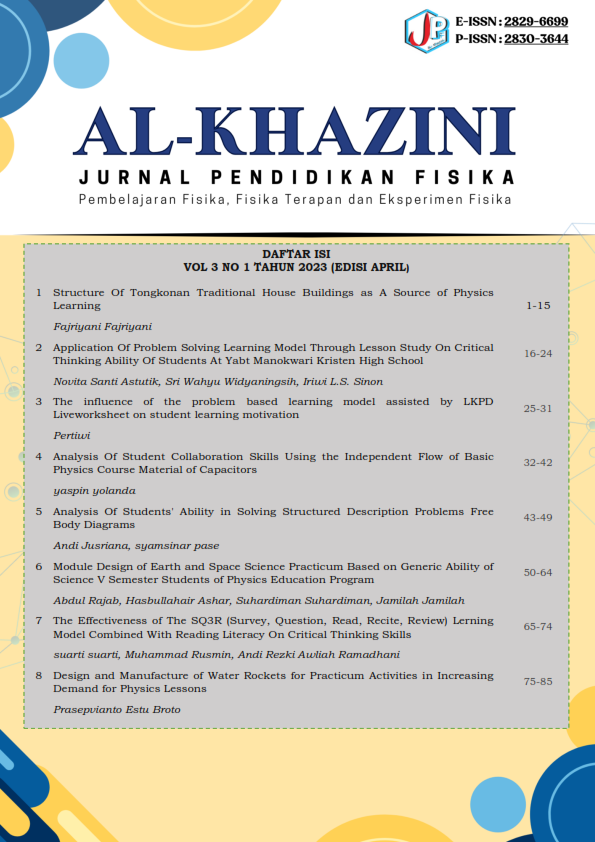 April
Vol. 3 No. 1 (2023)
April
Vol. 3 No. 1 (2023)Volume 3, Issue 1 (2023): April presents a collection of research studies focusing on physics education and instructional method development. The articles in this edition explore various topics, including the structure of Tongkonan traditional house buildings as a source of physics learning, the application of the problem-solving learning model through lesson study on students' critical thinking ability at Yabt Manokwari Christian High School, and the influence of the problem-based learning model assisted by LKPD Liveworksheet on student learning motivation. Additionally, there are analyses of students' collaboration skills in studying basic physics material on capacitors, as well as students' ability in solving structured description problems on free body diagrams. Other articles include the design of Earth and Space Science practicum modules based on students' generic abilities in the physics education program, the effectiveness of the SQ3R (Survey, Question, Read, Recite, Review) learning model combined with reading literacy on critical thinking skills, and the design and manufacture of water rockets for practicum activities to increase interest in physics lessons.
-
 Oktober
Vol. 2 No. 2 (2022)
Oktober
Vol. 2 No. 2 (2022)Volume 2, Issue 2 (2022): October presents a diverse range of studies focusing on physics education and assessment strategies. The articles in this issue explore various approaches to enhancing learning outcomes in physics, such as the implementation of blended learning through Google Classroom for natural disaster and disaster mitigation topics, the development of exam questions for end-of-semester assessments in science subjects, and an analysis of students' ability to complete professional competency tests in physics education. Additionally, the effectiveness of learning media based on the animated film Dr. Stone in improving learning outcomes for electromagnetic induction topics, the use of generative learning models to develop students' generic science skills in momentum and impulse topics, and the effectiveness of mnemonic learning methods in memorizing physics formulas are investigated. Furthermore, there are discussions on the effectiveness and creative thinking abilities of students in online learning during the Covid-19 pandemic, as well as the development of assessment instruments for cognitive experiments in Basic Physics I.
-
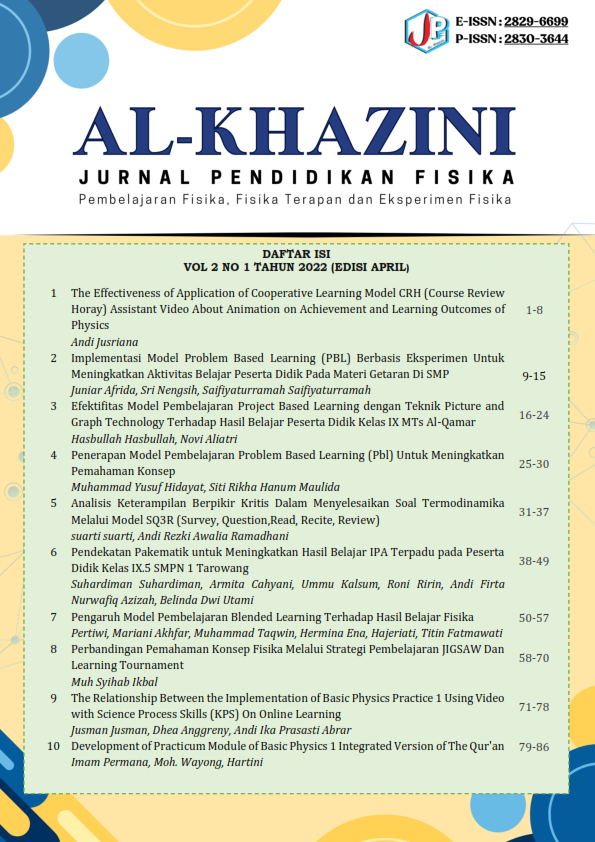 April
Vol. 2 No. 1 (2022)
April
Vol. 2 No. 1 (2022)Volume 2, Issue 1 (2022): April presents a series of studies in physics education aimed at evaluating various learning models and teaching techniques to enhance student learning outcomes. These articles include research on the effectiveness of the CRH (Course Review Horay) Assistant Video cooperative learning model with animation on physics achievement and learning outcomes, the implementation of problem-based learning models for vibration topics in secondary schools, and the effectiveness of project-based learning models with picture and graph technology techniques for ninth-grade students. Additionally, there are analyses of critical thinking skills in solving thermodynamics problems through the SQ3R model (Survey, Question, Read, Recite, Review), the Pakematik approach to improving integrated science learning outcomes, and the impact of blended learning models on physics learning outcomes. Other articles also discuss the comparison of physics concept understanding through JIGSAW and Learning Tournament learning strategies, as well as the relationship between the implementation of Basic Physics Practice 1 using videos and Science Process Skills (KPS) in online learning. Lastly, the development of a basic physics practicum module integrated with the Qur'an is explored.
-
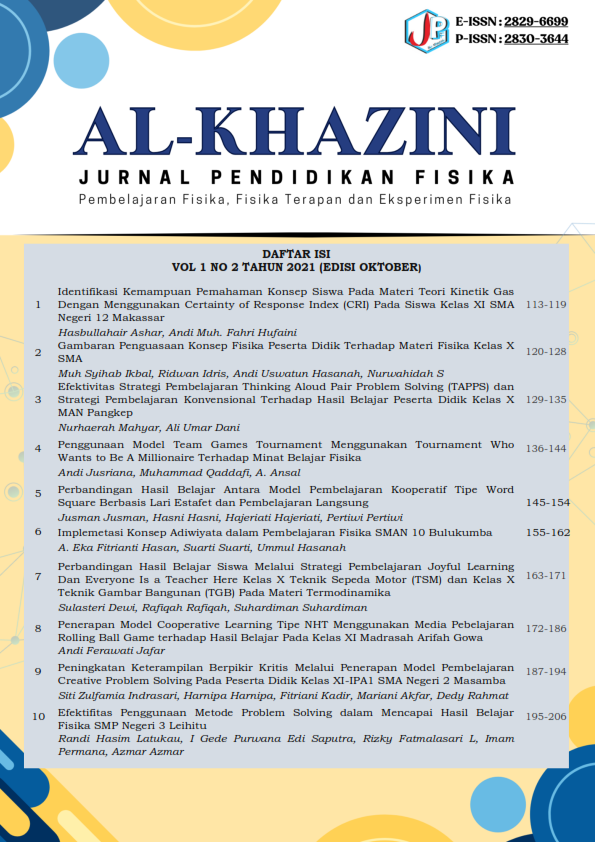 Oktober
Vol. 1 No. 2 (2021)
Oktober
Vol. 1 No. 2 (2021)Volume 1, Issue 2 (2021): October features various studies exploring the effectiveness of different teaching strategies and learning environments in physics education. These include investigations into students' conceptual understanding of gas kinetic theory, the mastery of physics concepts among high school students, and the impact of cooperative learning models on learning outcomes. Additionally, the issue examines the implementation of environmental sustainability concepts in physics education and compares learning outcomes between different teaching approaches. It also delves into improving critical thinking skills through creative problem-solving models and evaluates the effectiveness of problem-solving methods in achieving learning outcomes in middle school physics.
-
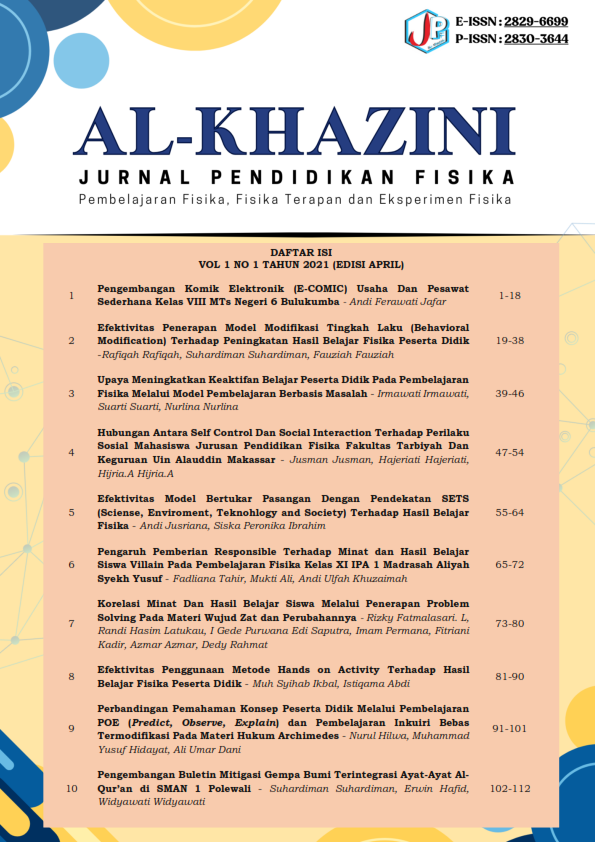 April
Vol. 1 No. 1 (2021)
April
Vol. 1 No. 1 (2021)The April 2021 edition of Volume 1, Issue 1 of this journal presents a variety of physics education articles. These include the development of electronic comics for 8th-grade students, the effectiveness of problem-based learning models, and the correlation between self-control and social interaction among university students. The journal also discusses the SETS learning model's efficacy in improving physics learning outcomes, the impact of responsibility on student interest and performance, and the application of problem-solving in the study of matter states and changes. Additionally, it covers articles on student conceptual understanding through POE and modified inquiry-based learning, as well as the development of earthquake mitigation bulletins integrated with Quranic verses at SMAN 1 Polewali.
